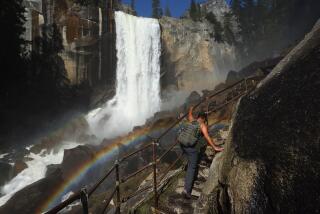Latest Casualties of Midwest Drought: Nesting Water Birds
- Share via
JAMESTOWN, N.D. — America’s prairie waterfowl, their numbers already depleted by decades of agricultural development and lost habitat, are threatened this summer by the worst drought since the Great Depression.
North Dakota, cited by the Agriculture Department as suffering more from the searing heat than any other state, is at the heart of the prairie pothole region, a 300,000-square-mile patch of glacial gouges that is a critical stop for migrating and nesting birds.
In a landscape resembling a vast piece of Swiss cheese, the potholes trap fresh water that creates the food and shelter for birds trying to reproduce. About 50% of all ducks in North America come from the prairie potholes.
Duck Population Down
But this year, because of record-breaking heat, a drastic drop in annual rainfall and a barren, dry winter, the U.S. Fish and Wildlife Service estimates the duck population in North Dakota is down 18% from last year and has decreased 22% in South Dakota since 1987. Federal counters estimate that North Dakota has 2.4 million ducks, South Dakota about 2 million.
Further, Fish and Wildlife aerial surveyors say, there has been a sharp decline in the number of water holes available to those birds attempting to hatch young. In North Dakota, the pond count is down 49% from last year; in South Dakota the number of available water holes has shrunk 42%.
“We’ve put transmitters on about 175 female mallards in North Dakota and Minnesota this season, and so far only five have hatched broods,” said Gary Krapu, a federal research biologist at the Northern Prairie Wildlife Research Center in Jamestown. “It’s likely fewer than 20 of those hens will produce broods this season.”
“If the drought lingers and populations continue to decline, Americans can expect to see far fewer waterfowl than they have traditionally known,” Krapu said.
Birds that flock to prairie pothole country, which spans parts of North and South Dakota, Minnesota, Montana and three Canadian provinces, include everything from tiny teals to majestic swans and endangered whooping cranes.
“I think the birds sensed drought from the beginning,” he said. “In April we had the worst dust storms since the 1930s. Maybe half the birds didn’t nest at all, and the other half made one attempt and gave up.”
More to Read
Sign up for Essential California
The most important California stories and recommendations in your inbox every morning.
You may occasionally receive promotional content from the Los Angeles Times.










